Capital Expenses
Capital expenses are the costs for fixed assets—the things that are typically carried on the books (reported on financial statements), last longer than a year, and provide recurring value. Buildings, vehicles, and equipment are typically capital expenses. Capital expenses hit the income statement in the form of depreciation. Your company Read more…






